Noise in the Mining Industry: Occupational Health Hazard and Control Strategies
VerifiedAdded on 2023/06/11
|9
|2266
|116
AI Summary
This article discusses noise as an occupational health hazard in the mining industry, legislative requirements, standard industry practices for elimination/minimisation of noise, and its effectiveness. It also covers how noise manifests in the mining industry and its negative effects on workers' health.
Contribute Materials
Your contribution can guide someone’s learning journey. Share your
documents today.
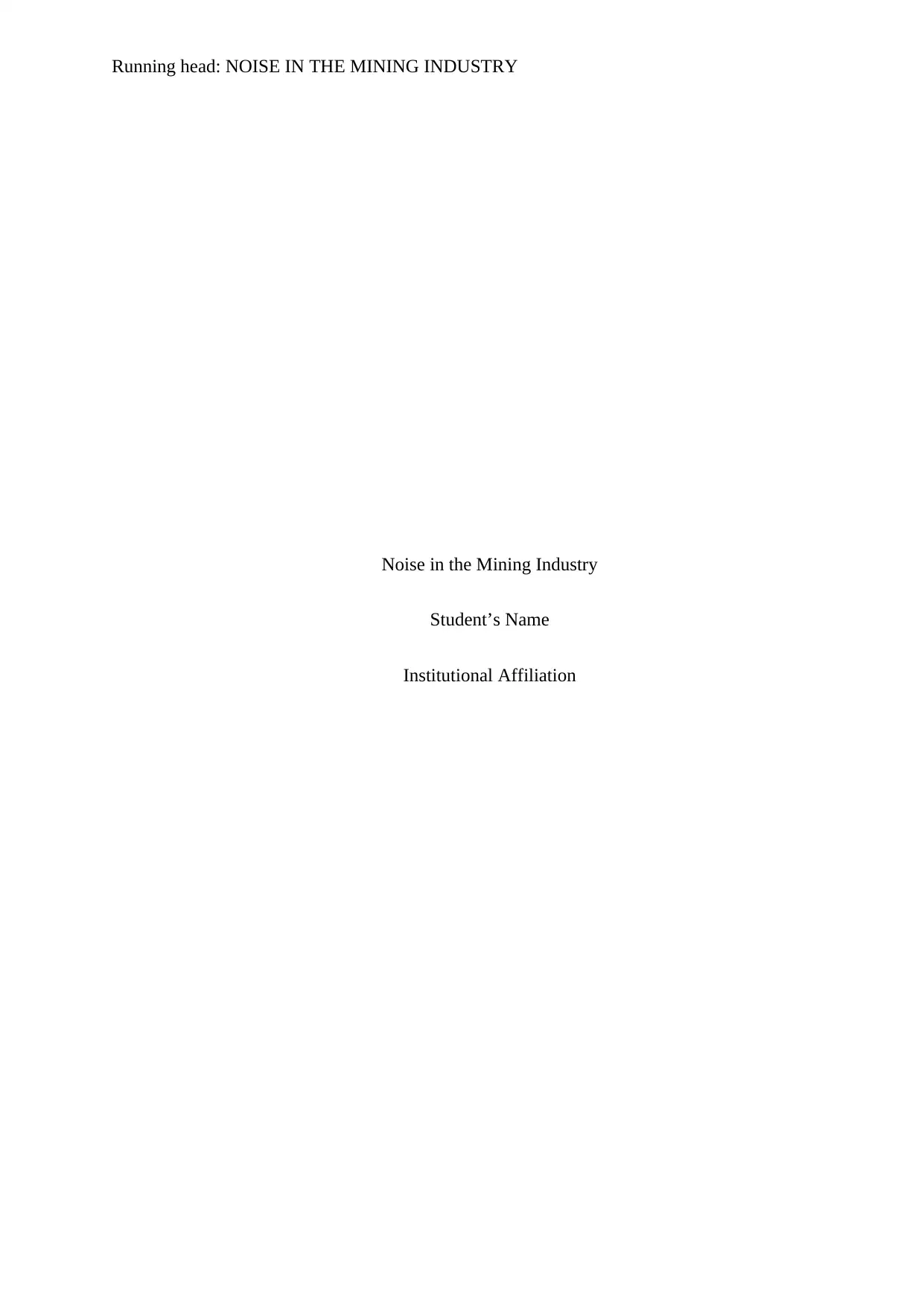
Running head: NOISE IN THE MINING INDUSTRY
Noise in the Mining Industry
Student’s Name
Institutional Affiliation
Noise in the Mining Industry
Student’s Name
Institutional Affiliation
Secure Best Marks with AI Grader
Need help grading? Try our AI Grader for instant feedback on your assignments.
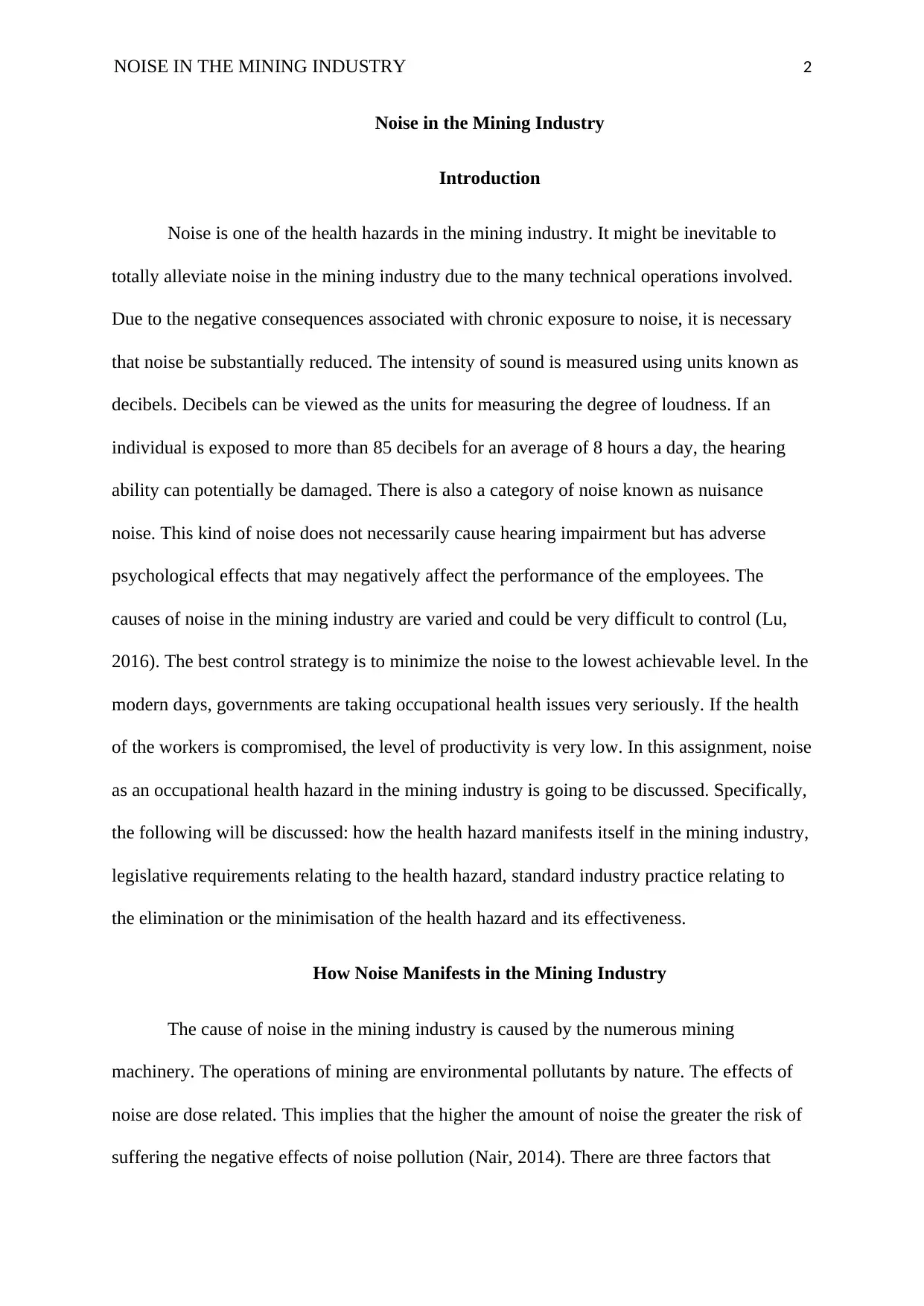
NOISE IN THE MINING INDUSTRY 2
Noise in the Mining Industry
Introduction
Noise is one of the health hazards in the mining industry. It might be inevitable to
totally alleviate noise in the mining industry due to the many technical operations involved.
Due to the negative consequences associated with chronic exposure to noise, it is necessary
that noise be substantially reduced. The intensity of sound is measured using units known as
decibels. Decibels can be viewed as the units for measuring the degree of loudness. If an
individual is exposed to more than 85 decibels for an average of 8 hours a day, the hearing
ability can potentially be damaged. There is also a category of noise known as nuisance
noise. This kind of noise does not necessarily cause hearing impairment but has adverse
psychological effects that may negatively affect the performance of the employees. The
causes of noise in the mining industry are varied and could be very difficult to control (Lu,
2016). The best control strategy is to minimize the noise to the lowest achievable level. In the
modern days, governments are taking occupational health issues very seriously. If the health
of the workers is compromised, the level of productivity is very low. In this assignment, noise
as an occupational health hazard in the mining industry is going to be discussed. Specifically,
the following will be discussed: how the health hazard manifests itself in the mining industry,
legislative requirements relating to the health hazard, standard industry practice relating to
the elimination or the minimisation of the health hazard and its effectiveness.
How Noise Manifests in the Mining Industry
The cause of noise in the mining industry is caused by the numerous mining
machinery. The operations of mining are environmental pollutants by nature. The effects of
noise are dose related. This implies that the higher the amount of noise the greater the risk of
suffering the negative effects of noise pollution (Nair, 2014). There are three factors that
Noise in the Mining Industry
Introduction
Noise is one of the health hazards in the mining industry. It might be inevitable to
totally alleviate noise in the mining industry due to the many technical operations involved.
Due to the negative consequences associated with chronic exposure to noise, it is necessary
that noise be substantially reduced. The intensity of sound is measured using units known as
decibels. Decibels can be viewed as the units for measuring the degree of loudness. If an
individual is exposed to more than 85 decibels for an average of 8 hours a day, the hearing
ability can potentially be damaged. There is also a category of noise known as nuisance
noise. This kind of noise does not necessarily cause hearing impairment but has adverse
psychological effects that may negatively affect the performance of the employees. The
causes of noise in the mining industry are varied and could be very difficult to control (Lu,
2016). The best control strategy is to minimize the noise to the lowest achievable level. In the
modern days, governments are taking occupational health issues very seriously. If the health
of the workers is compromised, the level of productivity is very low. In this assignment, noise
as an occupational health hazard in the mining industry is going to be discussed. Specifically,
the following will be discussed: how the health hazard manifests itself in the mining industry,
legislative requirements relating to the health hazard, standard industry practice relating to
the elimination or the minimisation of the health hazard and its effectiveness.
How Noise Manifests in the Mining Industry
The cause of noise in the mining industry is caused by the numerous mining
machinery. The operations of mining are environmental pollutants by nature. The effects of
noise are dose related. This implies that the higher the amount of noise the greater the risk of
suffering the negative effects of noise pollution (Nair, 2014). There are three factors that
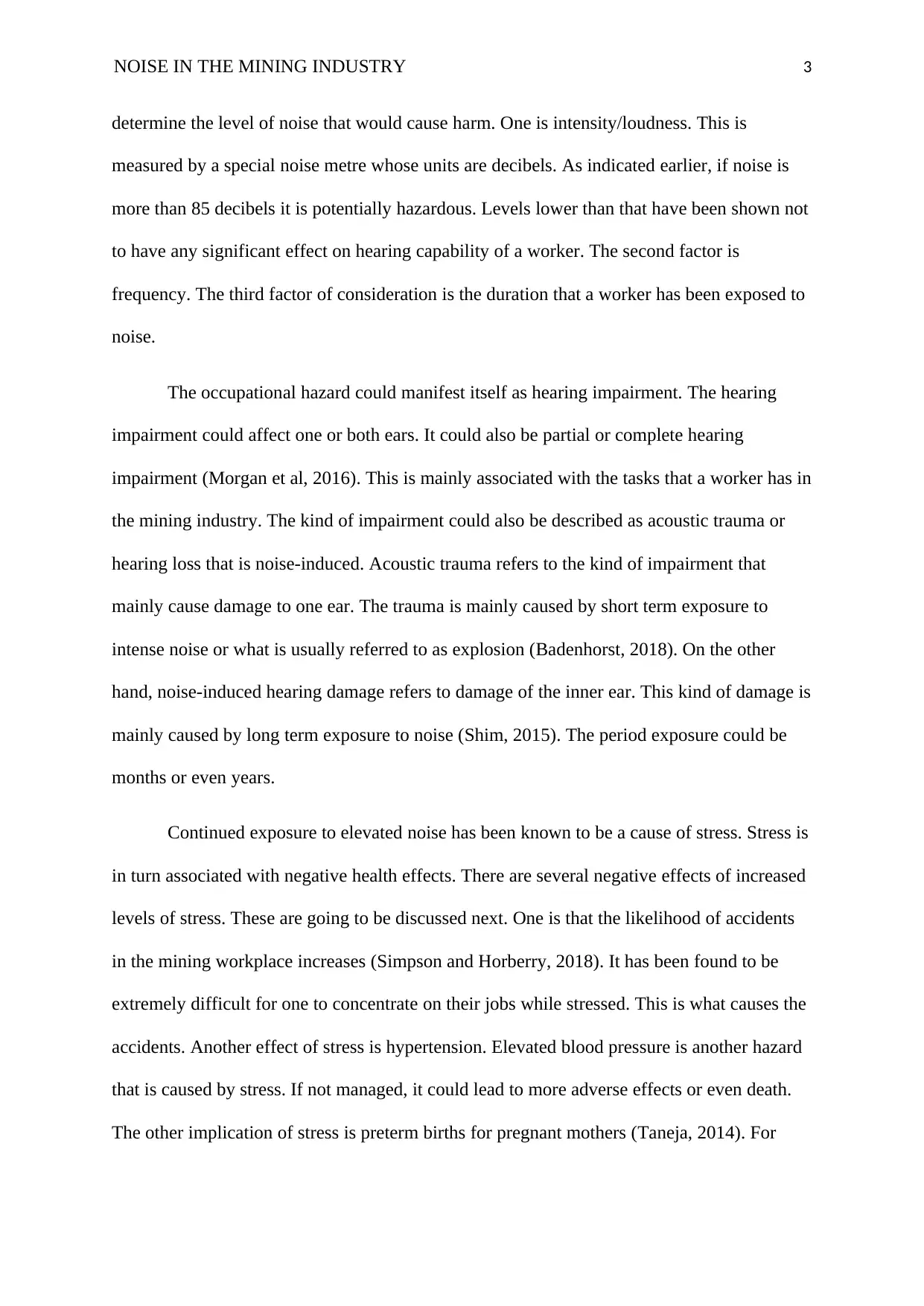
NOISE IN THE MINING INDUSTRY 3
determine the level of noise that would cause harm. One is intensity/loudness. This is
measured by a special noise metre whose units are decibels. As indicated earlier, if noise is
more than 85 decibels it is potentially hazardous. Levels lower than that have been shown not
to have any significant effect on hearing capability of a worker. The second factor is
frequency. The third factor of consideration is the duration that a worker has been exposed to
noise.
The occupational hazard could manifest itself as hearing impairment. The hearing
impairment could affect one or both ears. It could also be partial or complete hearing
impairment (Morgan et al, 2016). This is mainly associated with the tasks that a worker has in
the mining industry. The kind of impairment could also be described as acoustic trauma or
hearing loss that is noise-induced. Acoustic trauma refers to the kind of impairment that
mainly cause damage to one ear. The trauma is mainly caused by short term exposure to
intense noise or what is usually referred to as explosion (Badenhorst, 2018). On the other
hand, noise-induced hearing damage refers to damage of the inner ear. This kind of damage is
mainly caused by long term exposure to noise (Shim, 2015). The period exposure could be
months or even years.
Continued exposure to elevated noise has been known to be a cause of stress. Stress is
in turn associated with negative health effects. There are several negative effects of increased
levels of stress. These are going to be discussed next. One is that the likelihood of accidents
in the mining workplace increases (Simpson and Horberry, 2018). It has been found to be
extremely difficult for one to concentrate on their jobs while stressed. This is what causes the
accidents. Another effect of stress is hypertension. Elevated blood pressure is another hazard
that is caused by stress. If not managed, it could lead to more adverse effects or even death.
The other implication of stress is preterm births for pregnant mothers (Taneja, 2014). For
determine the level of noise that would cause harm. One is intensity/loudness. This is
measured by a special noise metre whose units are decibels. As indicated earlier, if noise is
more than 85 decibels it is potentially hazardous. Levels lower than that have been shown not
to have any significant effect on hearing capability of a worker. The second factor is
frequency. The third factor of consideration is the duration that a worker has been exposed to
noise.
The occupational hazard could manifest itself as hearing impairment. The hearing
impairment could affect one or both ears. It could also be partial or complete hearing
impairment (Morgan et al, 2016). This is mainly associated with the tasks that a worker has in
the mining industry. The kind of impairment could also be described as acoustic trauma or
hearing loss that is noise-induced. Acoustic trauma refers to the kind of impairment that
mainly cause damage to one ear. The trauma is mainly caused by short term exposure to
intense noise or what is usually referred to as explosion (Badenhorst, 2018). On the other
hand, noise-induced hearing damage refers to damage of the inner ear. This kind of damage is
mainly caused by long term exposure to noise (Shim, 2015). The period exposure could be
months or even years.
Continued exposure to elevated noise has been known to be a cause of stress. Stress is
in turn associated with negative health effects. There are several negative effects of increased
levels of stress. These are going to be discussed next. One is that the likelihood of accidents
in the mining workplace increases (Simpson and Horberry, 2018). It has been found to be
extremely difficult for one to concentrate on their jobs while stressed. This is what causes the
accidents. Another effect of stress is hypertension. Elevated blood pressure is another hazard
that is caused by stress. If not managed, it could lead to more adverse effects or even death.
The other implication of stress is preterm births for pregnant mothers (Taneja, 2014). For
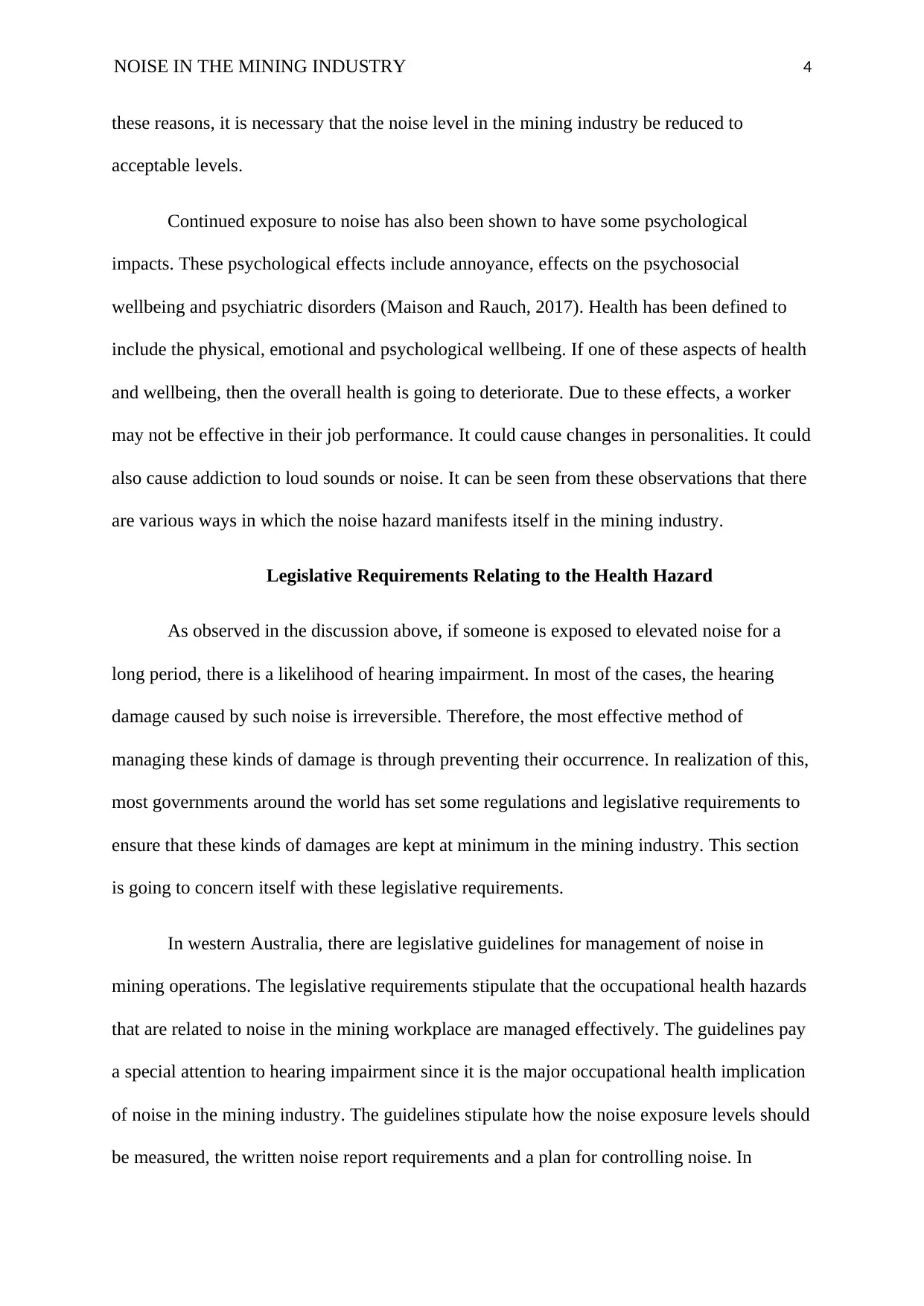
NOISE IN THE MINING INDUSTRY 4
these reasons, it is necessary that the noise level in the mining industry be reduced to
acceptable levels.
Continued exposure to noise has also been shown to have some psychological
impacts. These psychological effects include annoyance, effects on the psychosocial
wellbeing and psychiatric disorders (Maison and Rauch, 2017). Health has been defined to
include the physical, emotional and psychological wellbeing. If one of these aspects of health
and wellbeing, then the overall health is going to deteriorate. Due to these effects, a worker
may not be effective in their job performance. It could cause changes in personalities. It could
also cause addiction to loud sounds or noise. It can be seen from these observations that there
are various ways in which the noise hazard manifests itself in the mining industry.
Legislative Requirements Relating to the Health Hazard
As observed in the discussion above, if someone is exposed to elevated noise for a
long period, there is a likelihood of hearing impairment. In most of the cases, the hearing
damage caused by such noise is irreversible. Therefore, the most effective method of
managing these kinds of damage is through preventing their occurrence. In realization of this,
most governments around the world has set some regulations and legislative requirements to
ensure that these kinds of damages are kept at minimum in the mining industry. This section
is going to concern itself with these legislative requirements.
In western Australia, there are legislative guidelines for management of noise in
mining operations. The legislative requirements stipulate that the occupational health hazards
that are related to noise in the mining workplace are managed effectively. The guidelines pay
a special attention to hearing impairment since it is the major occupational health implication
of noise in the mining industry. The guidelines stipulate how the noise exposure levels should
be measured, the written noise report requirements and a plan for controlling noise. In
these reasons, it is necessary that the noise level in the mining industry be reduced to
acceptable levels.
Continued exposure to noise has also been shown to have some psychological
impacts. These psychological effects include annoyance, effects on the psychosocial
wellbeing and psychiatric disorders (Maison and Rauch, 2017). Health has been defined to
include the physical, emotional and psychological wellbeing. If one of these aspects of health
and wellbeing, then the overall health is going to deteriorate. Due to these effects, a worker
may not be effective in their job performance. It could cause changes in personalities. It could
also cause addiction to loud sounds or noise. It can be seen from these observations that there
are various ways in which the noise hazard manifests itself in the mining industry.
Legislative Requirements Relating to the Health Hazard
As observed in the discussion above, if someone is exposed to elevated noise for a
long period, there is a likelihood of hearing impairment. In most of the cases, the hearing
damage caused by such noise is irreversible. Therefore, the most effective method of
managing these kinds of damage is through preventing their occurrence. In realization of this,
most governments around the world has set some regulations and legislative requirements to
ensure that these kinds of damages are kept at minimum in the mining industry. This section
is going to concern itself with these legislative requirements.
In western Australia, there are legislative guidelines for management of noise in
mining operations. The legislative requirements stipulate that the occupational health hazards
that are related to noise in the mining workplace are managed effectively. The guidelines pay
a special attention to hearing impairment since it is the major occupational health implication
of noise in the mining industry. The guidelines stipulate how the noise exposure levels should
be measured, the written noise report requirements and a plan for controlling noise. In
Secure Best Marks with AI Grader
Need help grading? Try our AI Grader for instant feedback on your assignments.
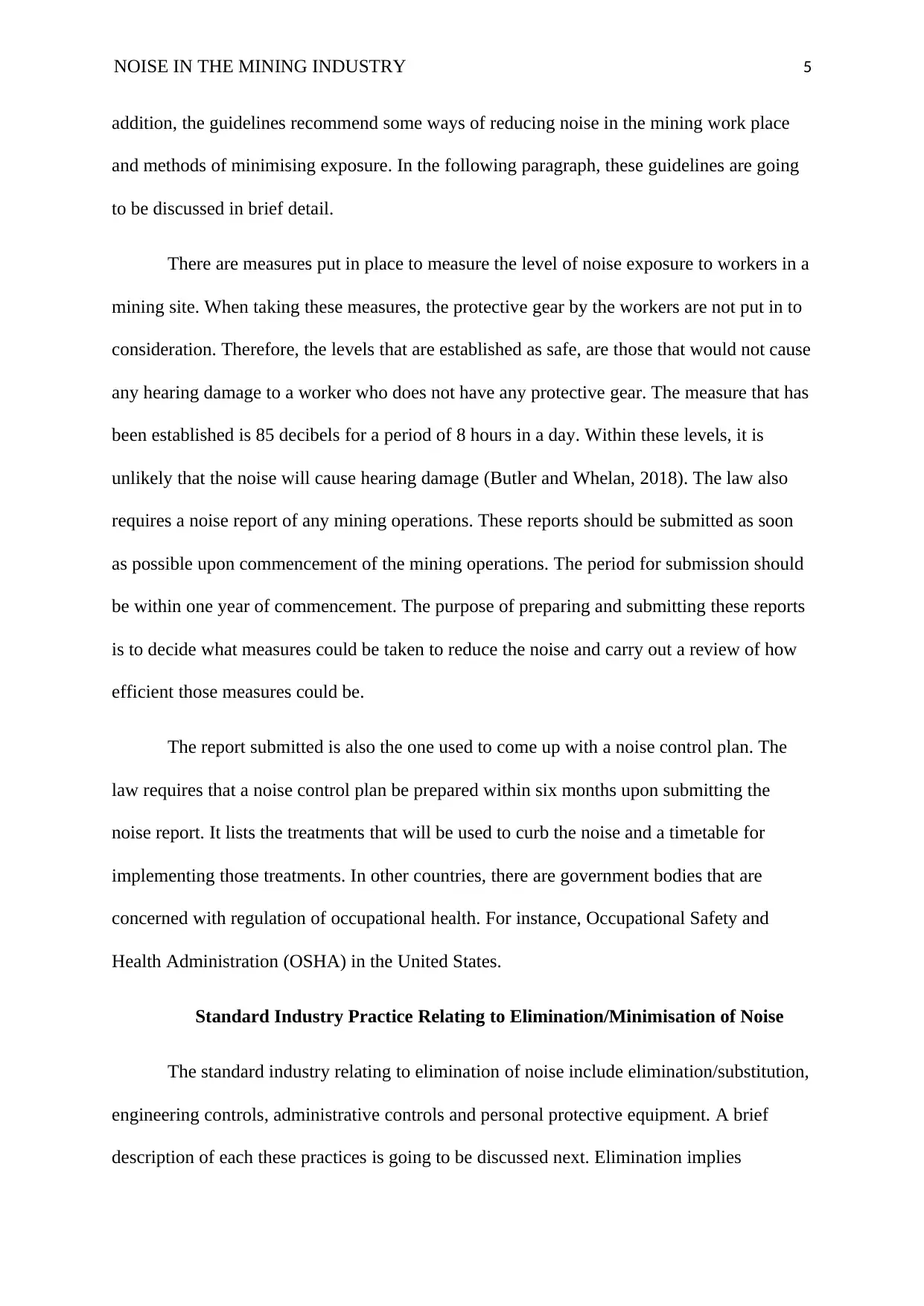
NOISE IN THE MINING INDUSTRY 5
addition, the guidelines recommend some ways of reducing noise in the mining work place
and methods of minimising exposure. In the following paragraph, these guidelines are going
to be discussed in brief detail.
There are measures put in place to measure the level of noise exposure to workers in a
mining site. When taking these measures, the protective gear by the workers are not put in to
consideration. Therefore, the levels that are established as safe, are those that would not cause
any hearing damage to a worker who does not have any protective gear. The measure that has
been established is 85 decibels for a period of 8 hours in a day. Within these levels, it is
unlikely that the noise will cause hearing damage (Butler and Whelan, 2018). The law also
requires a noise report of any mining operations. These reports should be submitted as soon
as possible upon commencement of the mining operations. The period for submission should
be within one year of commencement. The purpose of preparing and submitting these reports
is to decide what measures could be taken to reduce the noise and carry out a review of how
efficient those measures could be.
The report submitted is also the one used to come up with a noise control plan. The
law requires that a noise control plan be prepared within six months upon submitting the
noise report. It lists the treatments that will be used to curb the noise and a timetable for
implementing those treatments. In other countries, there are government bodies that are
concerned with regulation of occupational health. For instance, Occupational Safety and
Health Administration (OSHA) in the United States.
Standard Industry Practice Relating to Elimination/Minimisation of Noise
The standard industry relating to elimination of noise include elimination/substitution,
engineering controls, administrative controls and personal protective equipment. A brief
description of each these practices is going to be discussed next. Elimination implies
addition, the guidelines recommend some ways of reducing noise in the mining work place
and methods of minimising exposure. In the following paragraph, these guidelines are going
to be discussed in brief detail.
There are measures put in place to measure the level of noise exposure to workers in a
mining site. When taking these measures, the protective gear by the workers are not put in to
consideration. Therefore, the levels that are established as safe, are those that would not cause
any hearing damage to a worker who does not have any protective gear. The measure that has
been established is 85 decibels for a period of 8 hours in a day. Within these levels, it is
unlikely that the noise will cause hearing damage (Butler and Whelan, 2018). The law also
requires a noise report of any mining operations. These reports should be submitted as soon
as possible upon commencement of the mining operations. The period for submission should
be within one year of commencement. The purpose of preparing and submitting these reports
is to decide what measures could be taken to reduce the noise and carry out a review of how
efficient those measures could be.
The report submitted is also the one used to come up with a noise control plan. The
law requires that a noise control plan be prepared within six months upon submitting the
noise report. It lists the treatments that will be used to curb the noise and a timetable for
implementing those treatments. In other countries, there are government bodies that are
concerned with regulation of occupational health. For instance, Occupational Safety and
Health Administration (OSHA) in the United States.
Standard Industry Practice Relating to Elimination/Minimisation of Noise
The standard industry relating to elimination of noise include elimination/substitution,
engineering controls, administrative controls and personal protective equipment. A brief
description of each these practices is going to be discussed next. Elimination implies
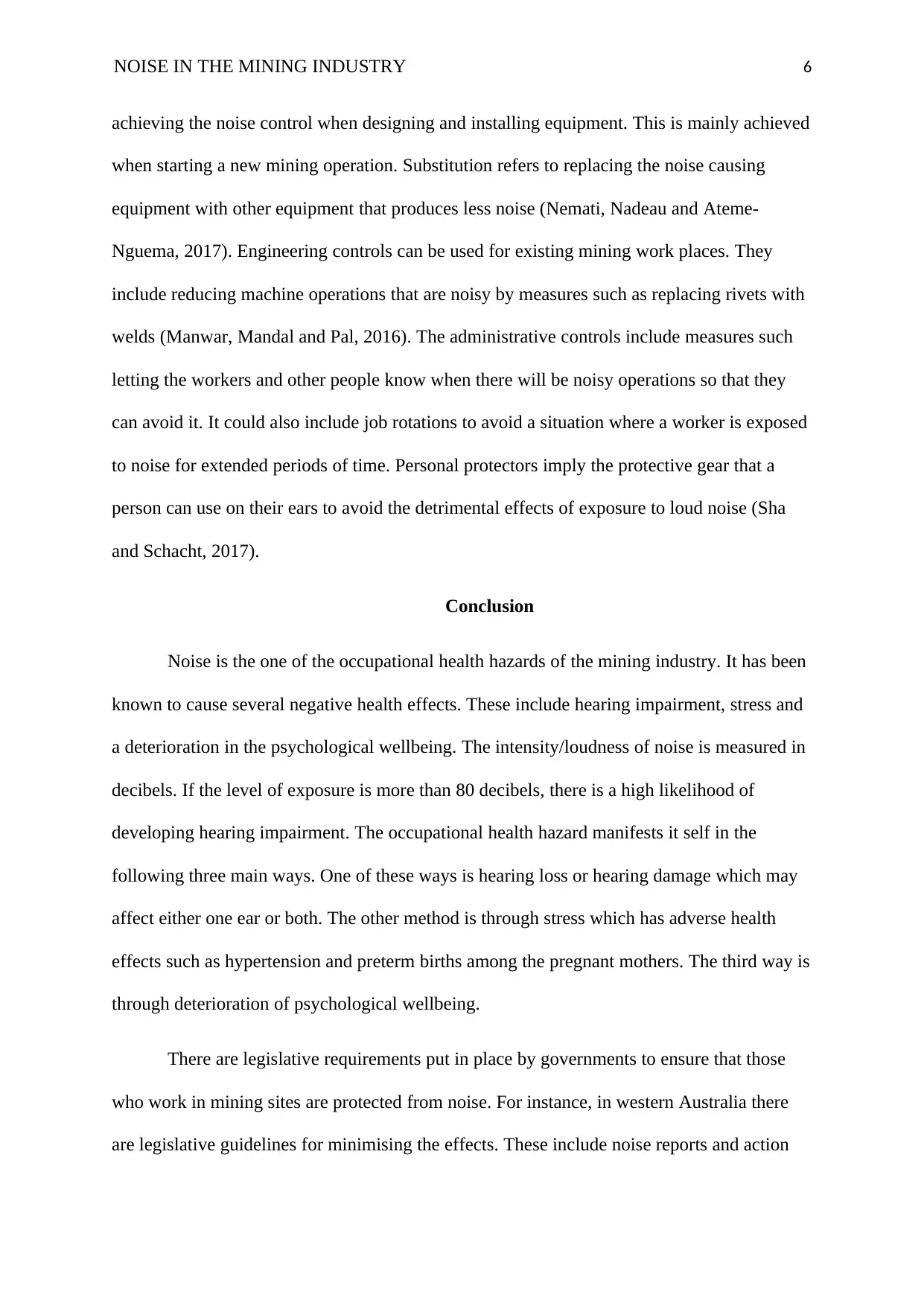
NOISE IN THE MINING INDUSTRY 6
achieving the noise control when designing and installing equipment. This is mainly achieved
when starting a new mining operation. Substitution refers to replacing the noise causing
equipment with other equipment that produces less noise (Nemati, Nadeau and Ateme-
Nguema, 2017). Engineering controls can be used for existing mining work places. They
include reducing machine operations that are noisy by measures such as replacing rivets with
welds (Manwar, Mandal and Pal, 2016). The administrative controls include measures such
letting the workers and other people know when there will be noisy operations so that they
can avoid it. It could also include job rotations to avoid a situation where a worker is exposed
to noise for extended periods of time. Personal protectors imply the protective gear that a
person can use on their ears to avoid the detrimental effects of exposure to loud noise (Sha
and Schacht, 2017).
Conclusion
Noise is the one of the occupational health hazards of the mining industry. It has been
known to cause several negative health effects. These include hearing impairment, stress and
a deterioration in the psychological wellbeing. The intensity/loudness of noise is measured in
decibels. If the level of exposure is more than 80 decibels, there is a high likelihood of
developing hearing impairment. The occupational health hazard manifests it self in the
following three main ways. One of these ways is hearing loss or hearing damage which may
affect either one ear or both. The other method is through stress which has adverse health
effects such as hypertension and preterm births among the pregnant mothers. The third way is
through deterioration of psychological wellbeing.
There are legislative requirements put in place by governments to ensure that those
who work in mining sites are protected from noise. For instance, in western Australia there
are legislative guidelines for minimising the effects. These include noise reports and action
achieving the noise control when designing and installing equipment. This is mainly achieved
when starting a new mining operation. Substitution refers to replacing the noise causing
equipment with other equipment that produces less noise (Nemati, Nadeau and Ateme-
Nguema, 2017). Engineering controls can be used for existing mining work places. They
include reducing machine operations that are noisy by measures such as replacing rivets with
welds (Manwar, Mandal and Pal, 2016). The administrative controls include measures such
letting the workers and other people know when there will be noisy operations so that they
can avoid it. It could also include job rotations to avoid a situation where a worker is exposed
to noise for extended periods of time. Personal protectors imply the protective gear that a
person can use on their ears to avoid the detrimental effects of exposure to loud noise (Sha
and Schacht, 2017).
Conclusion
Noise is the one of the occupational health hazards of the mining industry. It has been
known to cause several negative health effects. These include hearing impairment, stress and
a deterioration in the psychological wellbeing. The intensity/loudness of noise is measured in
decibels. If the level of exposure is more than 80 decibels, there is a high likelihood of
developing hearing impairment. The occupational health hazard manifests it self in the
following three main ways. One of these ways is hearing loss or hearing damage which may
affect either one ear or both. The other method is through stress which has adverse health
effects such as hypertension and preterm births among the pregnant mothers. The third way is
through deterioration of psychological wellbeing.
There are legislative requirements put in place by governments to ensure that those
who work in mining sites are protected from noise. For instance, in western Australia there
are legislative guidelines for minimising the effects. These include noise reports and action
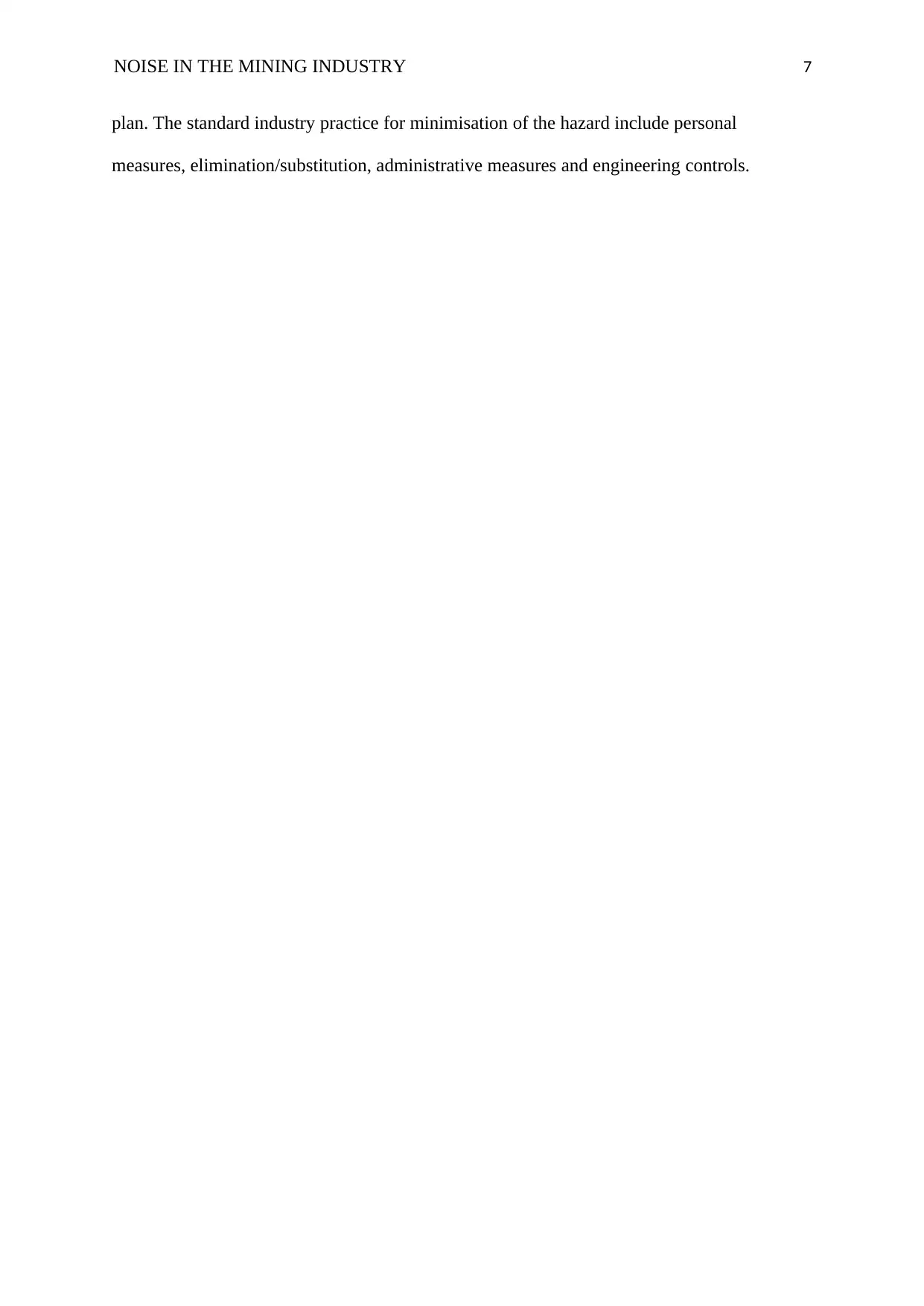
NOISE IN THE MINING INDUSTRY 7
plan. The standard industry practice for minimisation of the hazard include personal
measures, elimination/substitution, administrative measures and engineering controls.
plan. The standard industry practice for minimisation of the hazard include personal
measures, elimination/substitution, administrative measures and engineering controls.
Paraphrase This Document
Need a fresh take? Get an instant paraphrase of this document with our AI Paraphraser
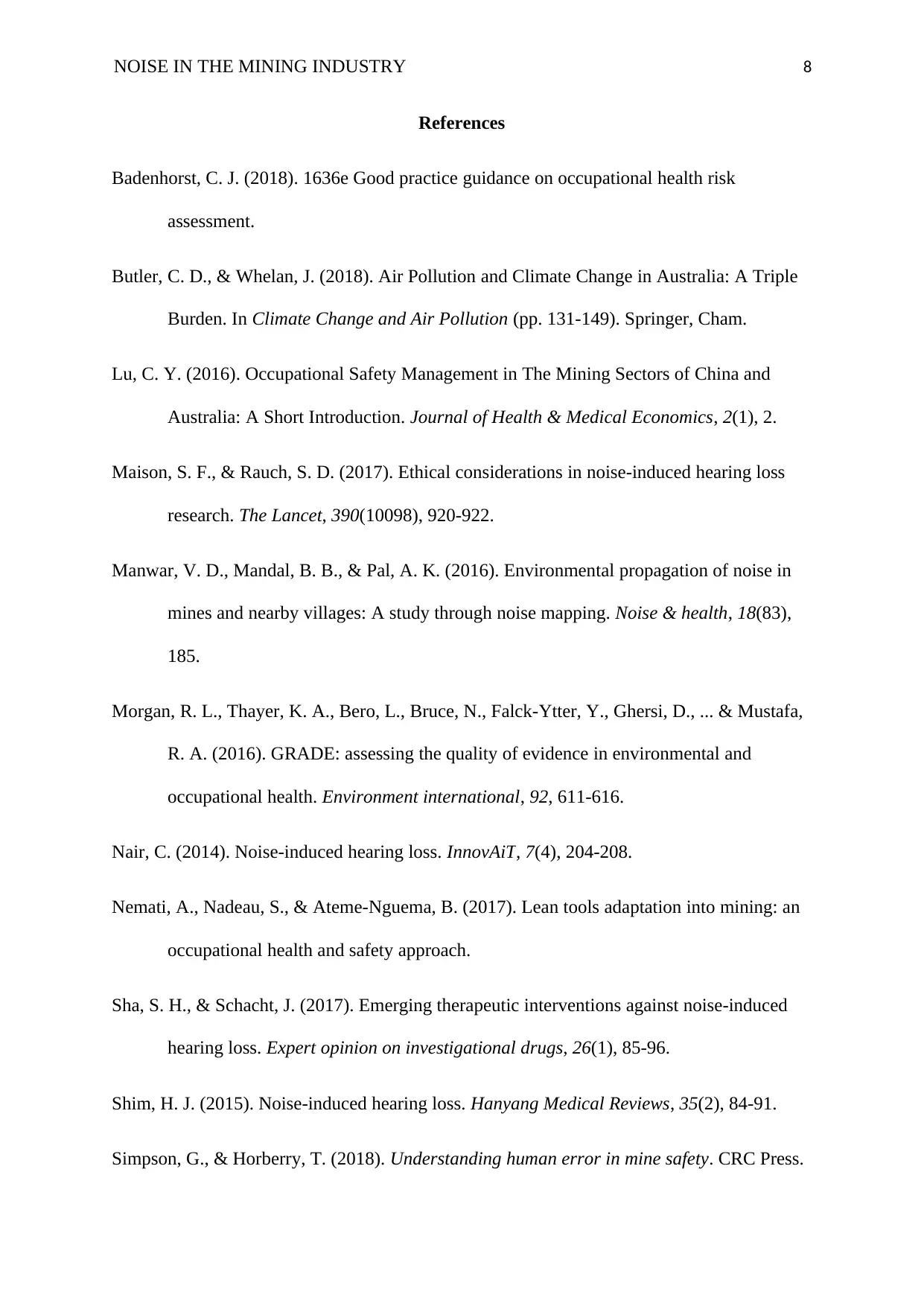
NOISE IN THE MINING INDUSTRY 8
References
Badenhorst, C. J. (2018). 1636e Good practice guidance on occupational health risk
assessment.
Butler, C. D., & Whelan, J. (2018). Air Pollution and Climate Change in Australia: A Triple
Burden. In Climate Change and Air Pollution (pp. 131-149). Springer, Cham.
Lu, C. Y. (2016). Occupational Safety Management in The Mining Sectors of China and
Australia: A Short Introduction. Journal of Health & Medical Economics, 2(1), 2.
Maison, S. F., & Rauch, S. D. (2017). Ethical considerations in noise-induced hearing loss
research. The Lancet, 390(10098), 920-922.
Manwar, V. D., Mandal, B. B., & Pal, A. K. (2016). Environmental propagation of noise in
mines and nearby villages: A study through noise mapping. Noise & health, 18(83),
185.
Morgan, R. L., Thayer, K. A., Bero, L., Bruce, N., Falck-Ytter, Y., Ghersi, D., ... & Mustafa,
R. A. (2016). GRADE: assessing the quality of evidence in environmental and
occupational health. Environment international, 92, 611-616.
Nair, C. (2014). Noise-induced hearing loss. InnovAiT, 7(4), 204-208.
Nemati, A., Nadeau, S., & Ateme-Nguema, B. (2017). Lean tools adaptation into mining: an
occupational health and safety approach.
Sha, S. H., & Schacht, J. (2017). Emerging therapeutic interventions against noise-induced
hearing loss. Expert opinion on investigational drugs, 26(1), 85-96.
Shim, H. J. (2015). Noise-induced hearing loss. Hanyang Medical Reviews, 35(2), 84-91.
Simpson, G., & Horberry, T. (2018). Understanding human error in mine safety. CRC Press.
References
Badenhorst, C. J. (2018). 1636e Good practice guidance on occupational health risk
assessment.
Butler, C. D., & Whelan, J. (2018). Air Pollution and Climate Change in Australia: A Triple
Burden. In Climate Change and Air Pollution (pp. 131-149). Springer, Cham.
Lu, C. Y. (2016). Occupational Safety Management in The Mining Sectors of China and
Australia: A Short Introduction. Journal of Health & Medical Economics, 2(1), 2.
Maison, S. F., & Rauch, S. D. (2017). Ethical considerations in noise-induced hearing loss
research. The Lancet, 390(10098), 920-922.
Manwar, V. D., Mandal, B. B., & Pal, A. K. (2016). Environmental propagation of noise in
mines and nearby villages: A study through noise mapping. Noise & health, 18(83),
185.
Morgan, R. L., Thayer, K. A., Bero, L., Bruce, N., Falck-Ytter, Y., Ghersi, D., ... & Mustafa,
R. A. (2016). GRADE: assessing the quality of evidence in environmental and
occupational health. Environment international, 92, 611-616.
Nair, C. (2014). Noise-induced hearing loss. InnovAiT, 7(4), 204-208.
Nemati, A., Nadeau, S., & Ateme-Nguema, B. (2017). Lean tools adaptation into mining: an
occupational health and safety approach.
Sha, S. H., & Schacht, J. (2017). Emerging therapeutic interventions against noise-induced
hearing loss. Expert opinion on investigational drugs, 26(1), 85-96.
Shim, H. J. (2015). Noise-induced hearing loss. Hanyang Medical Reviews, 35(2), 84-91.
Simpson, G., & Horberry, T. (2018). Understanding human error in mine safety. CRC Press.

NOISE IN THE MINING INDUSTRY 9
Taneja, M. K. (2014). Noise-induced hearing loss. Indian Journal of Otology, 20(4), 151.
Taneja, M. K. (2014). Noise-induced hearing loss. Indian Journal of Otology, 20(4), 151.
1 out of 9
Related Documents
Your All-in-One AI-Powered Toolkit for Academic Success.
+13062052269
info@desklib.com
Available 24*7 on WhatsApp / Email
![[object Object]](/_next/static/media/star-bottom.7253800d.svg)
Unlock your academic potential
© 2024 | Zucol Services PVT LTD | All rights reserved.





